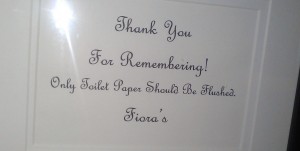 How many people do you think toss any old thing into public toilets? One in 100? Whether it’s more frequent or a rarer phenomenon, one thing’s for sure: there are enough “anything goes” toilet-tossers among us to warrant the creation of signs asking them not to do it.
How many people do you think toss any old thing into public toilets? One in 100? Whether it’s more frequent or a rarer phenomenon, one thing’s for sure: there are enough “anything goes” toilet-tossers among us to warrant the creation of signs asking them not to do it.
Of the many such signs I have encountered over the years, some have carried humorous messages, along the lines of “Your mother told us to remind you…” statements. Others vent frustration, with variations on “To the idiot who thinks it’s a good idea to discard Lego pieces and silverware…”
But until last week, never had I come across one that raised the level of discourse to what I would term “assumptive communication.”
There, inside Fiora’s, a rather elegant Geneva restaurant, was a well-appointed unisex rest room with a sign above the toilet that read, in attractive, flowing script:
“Thank you for remembering! Only toilet paper should be flushed.”
It’s a stroke of relational warmth, even though the “relationship” consists of someone who came up with those words at a single point in time and a diverse audience of people who come across it days, weeks, months and years later. To each of them, the note goes beyond asking to do something and proceeds straight to expressing appreciation for their “remembering” to do the right thing.
Giving People Credit for Behaving Responsibly
That is one powerful piece of assumptive communication.
It assumes that the individual reading it is someone who wants to be responsible. One of the most popular examples of assumptive communication is “thank you for not smoking,” a much warmer, more hopeful offspring of the curt “no smoking” or needy, hand-wringing vibe that emanates from those “please do not smoke” signs.
It’s a variation on the sales technique known as the assumptive close, wherein you are not questioning if the prospect wants to buy, but wondering how soon and in what quantity. Do you want small or large? Would you like to place your order today or tomorrow?
That approach frames the hoped-for answer in a “yes-yes” manner. People may choose to say “no,” but why plant that seed in case it is not there in the first place?
In media relations, it’s important to pick your spots with assumptive communication. Don’t overdo it. If you play this card on a media outreach that doesn’t measure up, then your credibility will plummet to “boy who cried wolf” depths.
But when you are developing a story pitch whose merit is strong—it’s not merely an adequate piece that might be of value—it may well be time to exude an appropriate level of confidence in your conversations and e-mail correspondence with reporters.
Respectful, Confident Ways to Connect With Reporters
While you obviously would never tell a reporter that he or she “has to do” a story or suggest that coverage is a “no brainer”—a cheap shot that tries to shame someone into a corner—there are respectful, yet confident ways to get the point across:
One example is when a story is a natural follow-up to a media outlet’s prior coverage. That was the case a few weeks ago as Inside Edge PR contacted a publication in the Fox Valley: “I wanted to share this news release below with you, before any other media outlet, since I know that the (newspaper) already devoted coverage in the immediate aftermath of the (news event)….”
In addition, I included a hyperlink to the newspaper’s original story.
For that media outreach, I followed up with similar introduction to other outlets, a few days later. I also referenced the original publication’s coverage as a way to legitimize the credibility of the story. Within 24 hours, two of the market’s biggest newspapers, including the Chicago Tribune, began pursuing the story.
Another common example of a hook to sink into the reporter’s or editor’s consciousness is when they have a way to localize the story, such as a person hailing from their publication area or with an event coming to their area.
Whatever makes the story compelling and attractive, succinctly spell it out and you should consistently enjoy watching its evolution from a “great fit” to well-earned publicity.
Related Posts:
On the Menu (And In Any Communication): Vary Your Words, Advance Your Story
Wildcat Winning Streak Illustrates Ease, Effectiveness of Passage-of-Time Storyline Hooks
